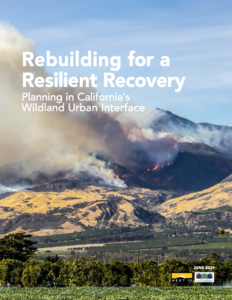Full Title: Rebuilding for a Resilient Recovery: Planning in California's Wildland Urban Interface
Author(s): F. Noel Perry, Colleen Kredell, Marcia E. Perry, Stephanie Leonard, Karen Chapple, Rob Olshansky, Molly Harris, Clay Kerchof, Jessica Finkel, Dori Ganetsos, Matt Gutierrez, Hanah Goldov, Laurel Mathews, Ben Ulrey, Lauren Willey, Sadie Wilson
Publisher(s): Next 10, UC Berkeley Center for Community Innovation
Publication Date: June 10, 2021
Full Text: Download Resource
Description (excerpt):
California must comprehensively reshape how we rebuild after wildfires—or risk an unthinkable surge in costs and major setbacks to the state’s housing supply amidst a record housing crisis. That’s the finding of Rebuilding for a Resilient Recovery: Planning in California’s Wildland Urban Interface, released today from researchers at the UC Berkeley Center for Community Innovation and non-partisan, non-profit think tank Next 10.
The researchers studied three communities recently affected by fires—Santa Rosa (Tubbs Fire, 2017), Ventura (Thomas Fire, 2017) and Paradise (Camp Fire, 2018)—and found that state and local land use policies, coupled with the state’s housing shortage, are ratcheting up the economic and human cost of wildfire by incentivizing rebuilding in the high risk-wildland urban interface (WUI), instead of redirecting development away from fire-prone areas. This is intensifying untenable safety, economic, and climate risks as the state prepares for another harrowing wildfire season in the midst of record drought.
Under current estimates, more than one in 12 Californian homes is located in an area identified as having a high risk of burning in a wildfire event, though researchers caution that this number is likely an underestimate, as the state has not updated its fire risk maps since 2007. In addition, over a half million new homes could well be built on underutilized residential land in the WUI in coming decades. Additionally, the insurance impacts of continued development in high-risk areas of the WUI place significant burdens on local economies. From 1964 to 1990, the insurance industry paid out an average of $100 million per year in fire insurance claims in California. From 2011 to 2018, that figure increased to $4 billion per year and—following the 2017 and 2018 fire seasons—insurers paid out approximately $26 billion to homeowners.
The report finds that pursuing either the “Managed Retreat” or “Resilience Nodes” pathways can reduce fire risk and household costs for residents, when compared with the “rebuilding as usual” scenario, while also helping to meet housing and climate goals. While the “Managed Retreat” scenario provides the largest safety and climate benefits, it presents new displacement risks for residents. The “Resilience Nodes” scenario offers the most potential for economic growth, with fewer social equity impacts, but also delivers less of a guarantee of lower future fire risks.
